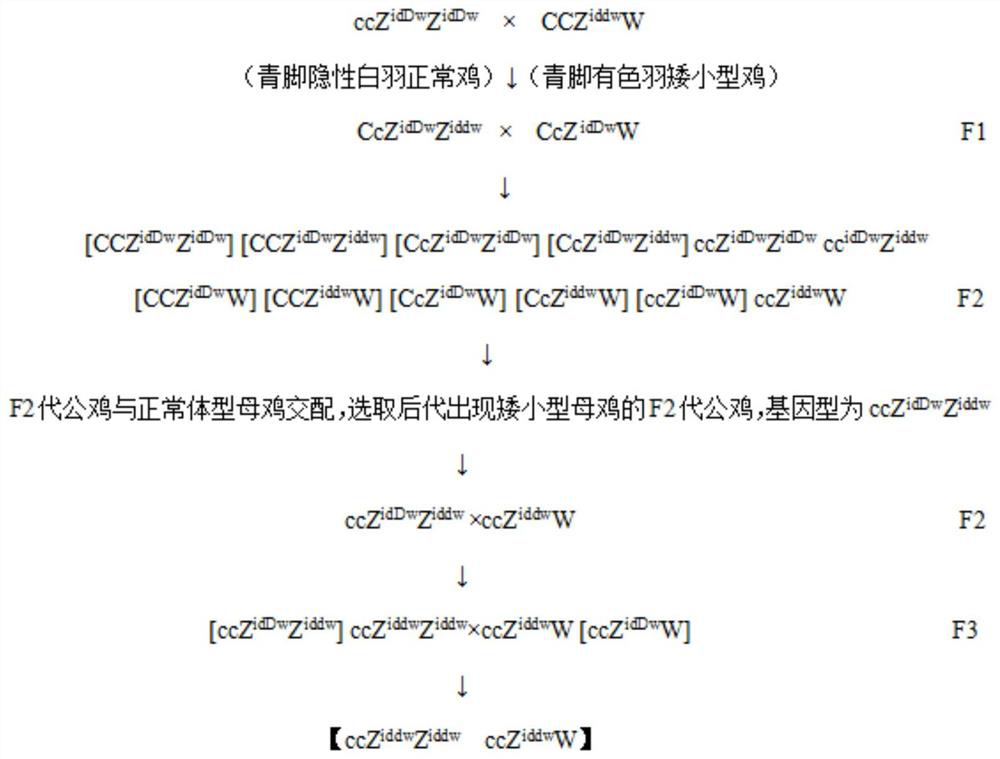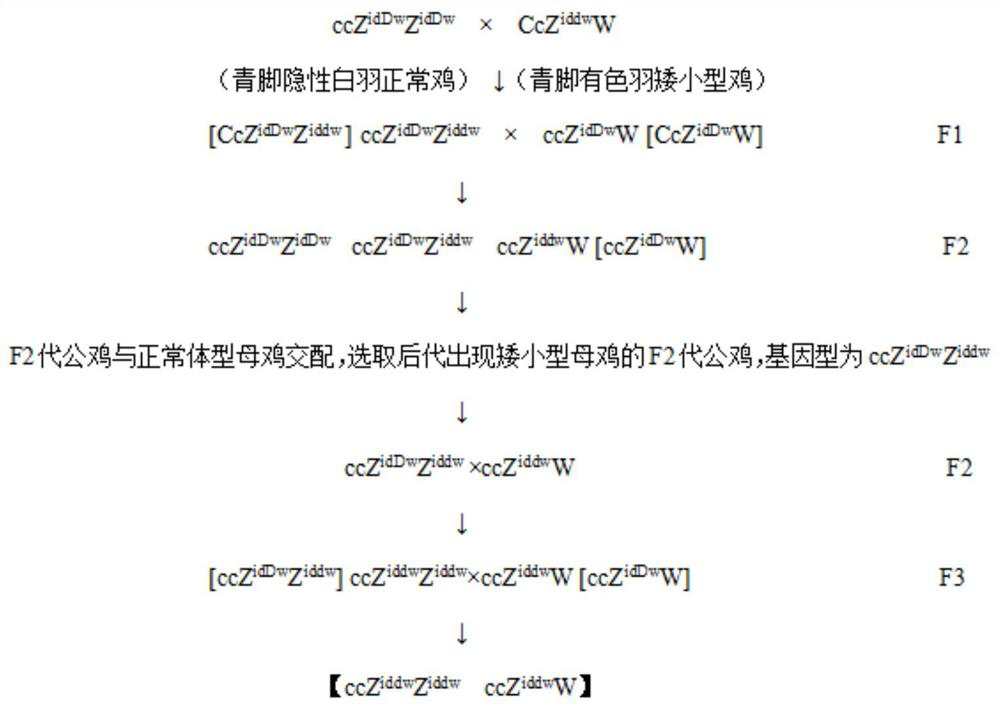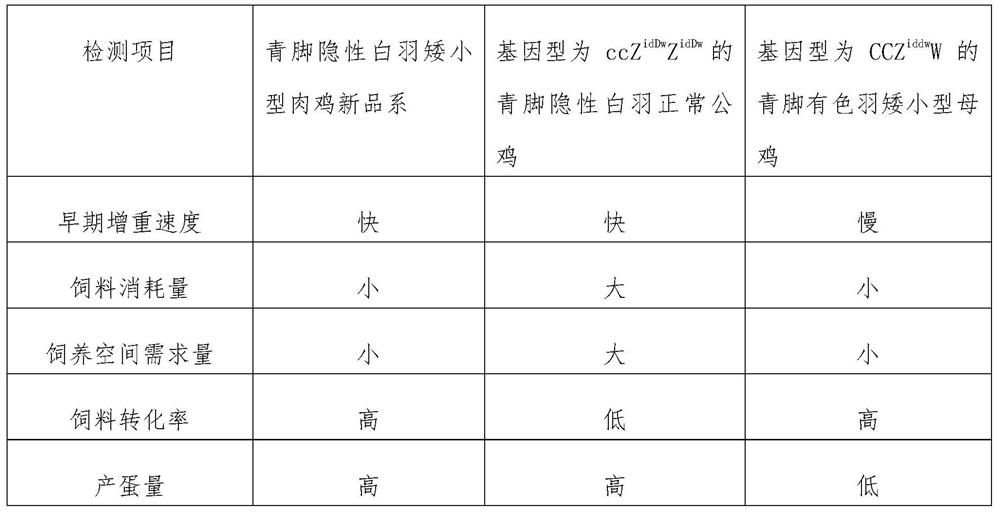Breeding method of a new strain of green-legged recessive white-feathered dwarf broiler chicken
A technology of recessive white feathers and breeding methods, applied in animal husbandry and other fields, can solve the problems of dwarf chickens with complex feather colors and unfavorable germplasm resources for breeding
- Summary
- Abstract
- Description
- Claims
- Application Information
AI Technical Summary
Problems solved by technology
Method used
Image
Examples
Embodiment 1
[0028] The present embodiment provides a method for cultivating the new strain of the green-footed recessive white-feather dwarf broiler, comprising the following steps:
[0029] (1) 20 genotypes were ccZ idDw Z idDw of green-footed recessive white-feathered normal roosters with 35 genotypes CCZ iddw W's green-footed colored-feather dwarf hens were bred to obtain F1 generation, of which the genotype of the F1 generation rooster was CcZ idDw Z iddw , the number is 63, and the hen genotype is CcZ idDw W, the quantity is 87;
[0030] (2) The F1 generation of roosters and hens are mated to produce the F2 generation, and the genotype of the F2 generation rooster is CCZ idDw Z idDw , CCZ idDw Z iddw , CcZ idDw Z idDw , CcZ idDw Z iddw , ccZ idDw Z idDw and ccZ idDw Z iddw , the corresponding numbers are 45, 52, 86, 90, 50 and 48 respectively, and the hen genotype is CCZ idDw W. CCZ iddw W. CcZ idDw W. CcZ iddw W. ccZ idDw W and ccZ iddw W, the corresponding qua...
Embodiment 2
[0035] (1) 15 genotypes were ccZ idDw Z idDw of green-footed recessive white-feathered normal males with 25 genotypes of CcZ iddw The green-footed heterozygous colored-feather dwarf hens of W were bred to obtain the F1 generation, and the genotypes of the F1 roosters were CcZ, respectively. idDw Z iddw and ccZ idDw Z iddw , the corresponding numbers are 28 and 25, respectively, and the hen genotype is ccZ idDw W and CcZ idDw W, the corresponding quantities are 34 and 39 respectively;
[0036] (2) Select the genotype in the F1 generation as ccZ idDw Z iddw The green-footed recessive white-feathered normal rooster with genotype ccZ idDw W's green-footed recessive white-feather normal hens were bred to obtain the F2 generation, and the genotypes of the F2 roosters were ccZ idDw Z idDw and ccZ idDw Z iddw , the corresponding numbers are 42 and 48, respectively, and the hen genotype is ccZ iddw W and ccZ idDw W, the corresponding numbers are 63 and 61 respectively; ...
Embodiment 3
[0040] The only difference between Example 3 and Example 1 is the number of males and hens for cross, backcross, cross and purebred, and other operations are the same.
[0041] (1) 30 genotypes were ccZ idDw Z idDw of green-footed recessive white-feathered normal males with 48 genotypes CCZ iddw W's green-footed colored-feather dwarf hens were bred to obtain F1 generation, of which the genotype of the F1 generation rooster was CcZ idDw Z iddw , the number is 78, and the hen genotype is CcZ idDw W, the quantity is 109;
[0042] (2) The F1 generation of roosters and hens are mated to produce the F2 generation, and the genotype of the F2 generation rooster is CCZ idDw Z idDw , CCZ idDw Z iddw , CcZ idDw Z idDw , CcZ idDw Z iddw , ccZ idDw Z idDw and ccZ idDw Z iddw , the corresponding numbers are 57, 68, 109, 120, 64 and 61 respectively, and the hen genotype is CCZ idDw W. CCZ iddw W. CcZ idDw W. CcZ iddw W. ccZ idDw W and ccZ iddw W, the corresponding quant...
PUM
 Login to View More
Login to View More Abstract
Description
Claims
Application Information
 Login to View More
Login to View More - R&D
- Intellectual Property
- Life Sciences
- Materials
- Tech Scout
- Unparalleled Data Quality
- Higher Quality Content
- 60% Fewer Hallucinations
Browse by: Latest US Patents, China's latest patents, Technical Efficacy Thesaurus, Application Domain, Technology Topic, Popular Technical Reports.
© 2025 PatSnap. All rights reserved.Legal|Privacy policy|Modern Slavery Act Transparency Statement|Sitemap|About US| Contact US: help@patsnap.com



